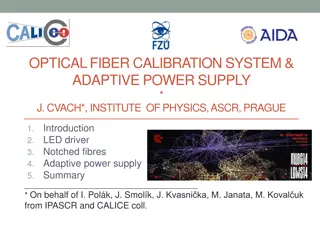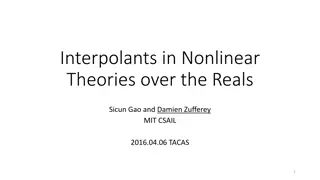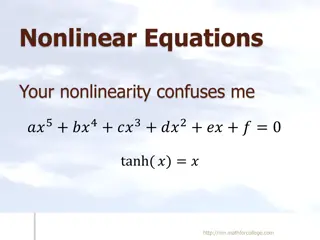
Nonlinear Regression Models and Exponential Model Analysis
Explore popular nonlinear regression models such as exponential, power, saturation growth, and polynomial models. Understand the process of finding constants for the exponential model through differentiation and equations. An example involving the relative intensity of radiation over time is also presented.
Download Presentation

Please find below an Image/Link to download the presentation.
The content on the website is provided AS IS for your information and personal use only. It may not be sold, licensed, or shared on other websites without obtaining consent from the author. If you encounter any issues during the download, it is possible that the publisher has removed the file from their server.
You are allowed to download the files provided on this website for personal or commercial use, subject to the condition that they are used lawfully. All files are the property of their respective owners.
The content on the website is provided AS IS for your information and personal use only. It may not be sold, licensed, or shared on other websites without obtaining consent from the author.
E N D
Presentation Transcript
Nonlinear Regression: Untransformed Data http://nm.MathForCollege.com Transforming Numerical Methods Education for STEM Undergraduates 1
Nonlinear Regression Some popular nonlinear regression models: 1. Exponential model: (? = ????) (? = ???) 2. Power model: ?? 3. Saturation growth model: ? = ? + ? 4. Polynomial model: (? = ?0+ ?1?+...+????) 2 http://numericalmethods.eng.usf.edu
Nonlinear Regression best fit ? = ?(?) Given n data points (x1,y1), (xn,yn), to the data, where ?(?) is a nonlinear function of ? (??,??) (?2,?2) ? = ?(?) (??,??) ?? ?(??) (?1,?1) Figure. Nonlinear regression model for discrete y vs. x data 3 http://numericalmethods.eng.usf.edu
Exponential Model ? = ????to the data. Given best fit (?1,?1),(?2,?2), ... , (??,??) (?1,?1) ? = ???? ?? ????? (??,??) (?2,?2) (??,??) Figure. Exponential model of nonlinear regression for y vs. x data 4 http://numericalmethods.eng.usf.edu
Finding Constants of Exponential Model The sum of the square of the residuals is defined as ? 2 ?? ????? ??= ?=1 Differentiate with respect to a and b ? ??? ??= 2 ?? ????? ???? = 0 ?=1 ? ??? ??= 2 ?? ????? ??????? = 0 ?=1 5 http://numericalmethods.eng.usf.edu
Finding Constants of Exponential Model Rewriting the equations, we obtain ? ? ??????+ ? ?2???= 0 ?=1 ?=1 ? ? ???????? ? ???2???= 0 ?=1 ?=1 6 http://numericalmethods.eng.usf.edu
Finding constants of Exponential Model Solving the first equation for a yields ? ?????? ?2??? ? = ?=1 ? ?=1 ? ? ???????? ? ???2???= 0 ?=1 ?=1 ? ? ? ?????? ?2??? ???????? ?=1 ???2???= 0 ? ?=1 ?=1 ?=1 7 http://numericalmethods.eng.usf.edu
Example 1-Exponential Model Many patients get concerned when a test involves injection of a radioactive material. For example for scanning a gallbladder, a few drops of Technetium- 99m isotope is used. Half of the Technetium-99m would be gone in about 6 hours. It, however, takes about 24 hours for the radiation levels to reach what we are exposed to in day-to-day activities. Below is given the relative intensity of radiation as a function of time. Table. Relative intensity of radiation as a function of time. t(hrs) 0 1 3 5 7 9 1.000 0.891 0.708 0.562 0.447 0.355 ? 8 http://numericalmethods.eng.usf.edu
Example 1-Exponential Model cont. The relative intensity is related to time by the equation ? = ???? Find: a) The value of the regression constants ? b) The half-life of Technetium-99m c) Radiation intensity after 24 hours and ? 9 http://numericalmethods.eng.usf.edu
Plot of data 10 http://numericalmethods.eng.usf.edu
Constants of the Model ? = ???? The value of is found by solving the nonlinear equation ? ? ? ?????? ?2??? ???????? ?=1 ???2???= 0 ? ? = ? ?=1 ?=1 ?=1 ? ?????? ?2??? ? = ?=1 ? ?=1 11 http://numericalmethods.eng.usf.edu
Plotting the Equation in MATLAB ? ???????? ?=1 ?=1 ? ? ?????? ?2??? ???2???= 0 ? ? = ? ?=1 ?=1 t (hrs) 0 1 3 5 7 9 1.000 0.891 0.708 0.562 0.447 0.355 12 http://numericalmethods.eng.usf.edu
Setting up the Equation in MATLAB ? ???????? ?=1 ?=1 ? ? ?????? ?2??? ???2???= 0 ? ? = ? ?=1 ?=1 ? = 0.1151 t=[0 1 3 5 7 9] gamma=[1 0.891 0.708 0.562 0.447 0.355] syms lamda sum1=sum(gamma.*t.*exp(lamda*t)); sum2=sum(gamma.*exp(lamda*t)); sum3=sum(exp(2*lamda*t)); sum4=sum(t.*exp(2*lamda*t)); f=sum1-sum2/sum3*sum4; 13 http://numericalmethods.eng.usf.edu
Calculating the Other Constant The value of A can now be calculated 6 ?????? ?2??? ? = ?=1 6 ?=1 = 0.9998 The exponential regression model then is ? = 0.9998 ? 0.1151? 14 http://numericalmethods.eng.usf.edu
Plot of data and regression curve ? = 0.9998 ? 0.1151? 15 http://numericalmethods.eng.usf.edu
Relative Intensity After 24 hrs The relative intensity of radiation after 24 hours ? = 0.9998 ? 0.1151 24 = 6.3160 10 2 This result implies that only 6.316 10 2 0.9998 radioactive intensity is left after 24 hours. 100 = 6.317% 16 http://numericalmethods.eng.usf.edu
Homework What is the half-life of Technetium-99m isotope? Write a program in the language of your choice to find the constants of the model. Compare the constants of this regression model with the one where the data is transformed. What if the model was ? = ??? 17 http://numericalmethods.eng.usf.edu





















